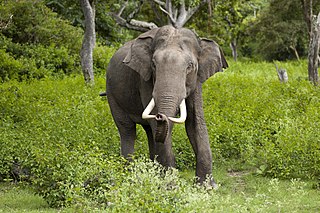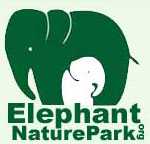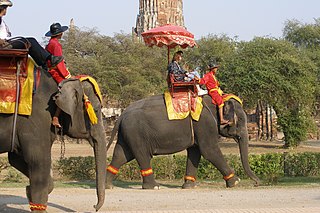
A circus is a company of performers who put on diverse entertainment shows that may include clowns, acrobats, trained animals, trapeze acts, musicians, dancers, hoopers, tightrope walkers, jugglers, magicians, ventriloquists, and unicyclists as well as other object manipulation and stunt-oriented artists. The term circus also describes the field of performance, training and community which has followed various formats through its 250-year modern history. Although not the inventor of the medium, Newcastle-under-Lyme born Philip Astley is credited as the father of the modern circus.

Execution by elephant was a method of capital punishment in South and Southeast Asia, particularly in India, where Asian elephants were used to crush, dismember, or torture captives during public executions. The animals were trained to kill victims immediately or to torture them slowly over a prolonged period. Most commonly employed by royalty, the elephants were used to signify both the ruler's power of life and death over his subjects and his ability to control wild animals.

The Asian elephant, also known as the Asiatic elephant, is the only living species of the genus Elephas and is distributed throughout the Indian subcontinent and Southeast Asia, from India in the west, Nepal in the north, Sumatra in the south, and to Borneo in the east. Three subspecies are recognised—E. m. maximus from Sri Lanka, E. m. indicus from mainland Asia and E. m. sumatranus from the island of Sumatra. Formerly, there was also the Syrian elephant or Western Asiatic elephant which was the westernmost population of the Asian elephant. This subspecies became extinct in ancient times. Skeletal remains of E. m. asurus have been recorded from the Middle East: Iran, Iraq, Syria, and Turkey from periods dating between at least 1800 BC and likely 700 BC. It is one of only three living species of elephants or elephantids anywhere in the world, the others being the African bush elephant and African forest elephant. It is the second largest species of elephant after the African bush elephant.

Cruelty to animals, also called animal abuse, animal neglect or animal cruelty, is the infliction by omission (neglect) or by commission by humans of suffering or harm upon non-human animals. More narrowly, it can be the causing of harm or suffering for specific achievements, such as killing animals for entertainment; cruelty to animals sometimes encompasses inflicting harm or suffering as an end in itself, referred to as zoosadism.

The Surin Elephant Round-up is a cultural festival held every year in Surin Province, Isan, Thailand. Usually the event is organized during the third week of November on the weekend. The festival has its origins in the royal hunts which were conducted in Surin Province during medieval times. The indigenous residents of Surin, the Kuy, have been traditional practitioners of corralling elephants and training them as working animals. When the Ayutthaya Kingdom came into power these hunts were converted into a public extravaganza and wild elephants were replaced with tame ones. The festival, in its contemporary form, was first organized in the 1960s when civil war in Cambodia and the steady decline in economic value of elephants forced the elephant handlers (mahouts) to seek occupations in the entertainment and tourism industry.

Elephants found in Kerala, the Indian elephants, are one of three recognized subspecies of the Asian elephant. Since 1986, Asian elephants have been listed as endangered by IUCN as the population has declined by at least 50% over the last three generations, estimated to be 25,600 to 32,750 in the wild. The species is pre-eminently threatened by habitat loss, degradation and fragmentation. Along with a large population of wild elephants, Kerala has more than seven hundred captive elephants. Most of them are owned by temples and individuals. They are used for religious ceremonies in and around the temples, and some churches, and a few elephants work at timber yards.

Bile bears, sometimes called battery bears, are bears kept in captivity to harvest their bile, a digestive fluid produced by the liver and stored in the gallbladder, which is used by some traditional Asian medicine practitioners. It is estimated that 12,000 bears are farmed for bile in China, South Korea, Laos, Vietnam, and Myanmar. Demand for the bile has been found in those nations as well as in some others, such as Malaysia and Japan.

Konni, also spelt Konny, is a town and taluk headquarters in Pathanamthitta district of Kerala, India. Konni is known for its elephant cages, forests, and rubber plantations. It is also known as "Aanakoodinte Nadu". Nearest town is Pathanamthitta. Konni is located 32 km (20 mi) from Chengannur railway station and NH 183 in Chengannur. It is well-connected via Muvattupuzha - Punalur state highway. Buses ply frequently from Pathanamthitta KSRTC bus station to Konni.

Elephant Nature Park is a sanctuary and rescue centre for elephants in Mae Taeng District, Chiang Mai Province, Northern Thailand, approximately 60 kilometres (37 mi) from Chiang Mai City, co-founded by Sangduen "Lek" Chailert. In 2013 Erawan Elephant Retirement Park opened in western Thailand as an offshoot. By 2016 there were branch elephant parks in Surin and in Cambodia, and there were plans to open a fifth park in Phuket. By then the work was coordinated by the Save Elephant Foundation.
According to the United States Department of State, "Thailand is a source, destination, and transit country for men, women, and children subjected to forced labour and sex trafficking." Thailand's relative prosperity attracts migrants from neighboring countries who flee conditions of poverty and, in the case of Burma, military repression. Significant illegal migration to Thailand presents traffickers with opportunities to coerce or defraud undocumented migrants into involuntary servitude or sexual exploitation. Police who investigated reaching high-profile authorities also received death threats in 2015.

A khedda or the Khedda system was a stockade trap for the capture of a full herd of elephants that was used in India; other methods were also used to capture single elephants. The elephants were driven into the stockade by skilled mahouts mounted on domesticated elephants. This method was practiced widely in North-east India, particularly in the state of Assam, mostly in South India, and in particular in the erstwhile Mysore State state.

Mela shikar is a traditional method of capturing wild elephants for captive use. These methods get employed in Burma, Thailand, Vietnam, Laos and Cambodia and in Assam in India. The process involves lassoing a wild elephant from the back of a trained one, called a koonki. This practice is prevalent in the northeastern part of India, especially in Assam, and is one of the methods seen in ancient India. Other traditional elephant capture methods include: khedda, byle shikar, snaring, pit method, and decoying by using a female koonki to lure a male elephant. Mela shikar used to be organized twice a year – after Durga Puja and during Bihu.
Sex trafficking in Thailand is human trafficking for the purpose of sexual exploitation and slavery that occurs in the Kingdom of Thailand. Thailand is a country of origin, destination, and transit for sex trafficking. The sexual exploitation of children in Thailand is a problem. In Thailand, close to 40,000 children under the age of 16 are believed to be in the sex trade, working in clubs, bars, and brothels.

Elephants can be found in various captive facilities such as a zoo, sanctuary, circus, or camp, usually under veterinary supervision. They can be used for educational, entertainment, or work purposes.

The elephant has been a contributor to Thai society and its icon for many centuries. The elephant has had a considerable impact on Thai culture. The Thai elephant is the official national animal of Thailand. The elephant found in Thailand is the Indian elephant, a subspecies of the Asian elephant. In the early-1900s there were an estimated 100,000 captive elephants in Thailand. In mid-2007 there were an estimated 3,456 captive elephants left in Thailand and roughly a thousand wild elephants. By 2017 the number of captive elephants had risen to an estimated 3,783. The elephant became an endangered species in Thailand in 1986.

Animal welfare in Thailand relates to the treatment of animals in fields such as agriculture, hunting, medical testing, tourism, and the domestic ownership of animals. It is distinct from animal conservation.

Konni Aanakkoodu located in Konni is a well known training center for elephant's in Kerala. Its at a distance of 11 km from Pathanamthitta town.

The Phuket Zoo was a zoo located in Phuket, Thailand. It was founded as a private zoo in 1997. The zoo was located near the Mueang Phuket district and the Phuket Bay. The zoo had been embroiled in controversy over its lack of animal welfare standards and allegations of extreme cruelty to animals.
Sex trafficking in China is human trafficking for the purpose of sexual exploitation and slavery that occurs in the People's Republic of China. China, the world's second-most populous country, has the second highest number of human trafficking victims in the world. It is a country of origin, destination, and transit for sexually trafficked persons.
Sex trafficking in Myanmar is human trafficking for the purpose of sexual exploitation and slavery that occurs in the Republic of the Union of Myanmar. Myanmar is primarily a source and transit country for sexually trafficked persons.















